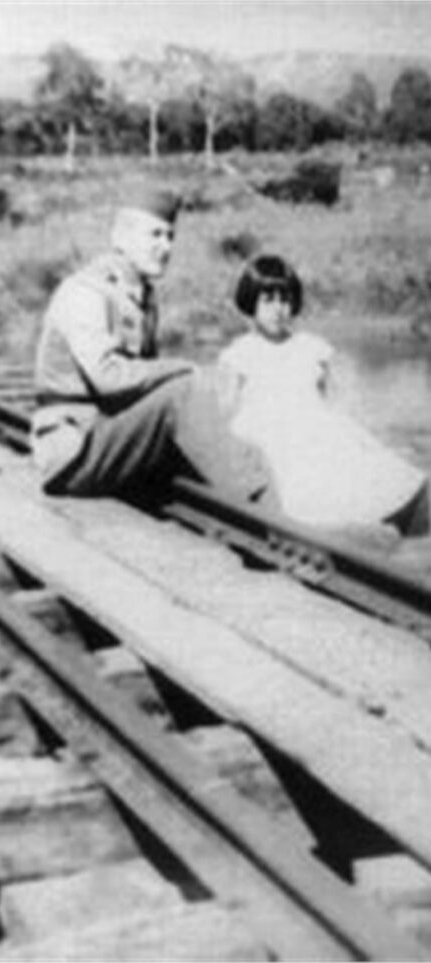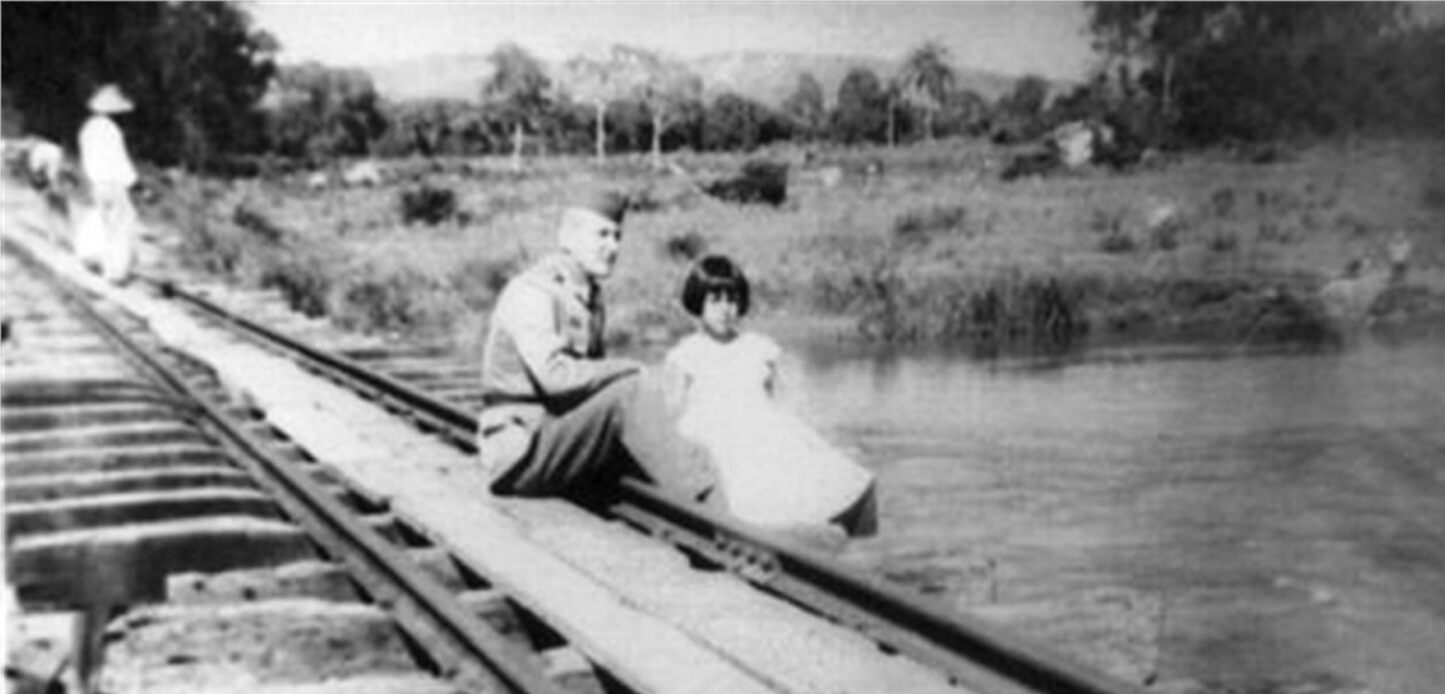Serra de São José
Upon arriving in Tiradentes, visitors are swiftly entranced by the breathtaking beauty of Serra de São José, which carries the city's old name: “São José del-Rei”. This majestic mountain range holds the distinction of being the site where the first gold nuggets and other precious metals were discovered, marking the onset of a century-long mining era. The mountains also provided a rich source of mineral quartzite, which was skillfully utilized by enslaved individuals in the construction of Tiradentes’ pavements.
Beyond its historical significance, Serra de São José is a vital cultural, archaeological, and ecological asset to the region. Stretching across an expanse of 15 km², it spans the municipalities of Tiradentes, Coronel Xavier Chaves, Prados, Santa Cruz de Minas, and São João del-Rei. Within its borders, two distinct ecosystems thrive: the lush Atlantic Forest and the diverse Cerrado, each boasting numerous springs and cascading waterfalls, including the scenic Mãe-D'Água Forest. In the 1970s, efforts to preserve this natural treasure began in earnest, culminating in the establishment of the São José Environmental Preservation Area (APA São José) in 1990. The primary goal of the APA is to mitigate the adverse impacts of mining, deforestation, and other forms of environmental degradation, while simultaneously safeguarding the region's precious water resources, diverse flora, and wildlife.
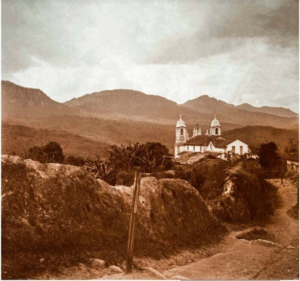
Matriz de Santo Antônio Church and Serra de São José. Miguel Aun, 1930s. Olinto Rodrigues dos Santos Filho digital collection, available on Facebook. From the book “Tiradentes, cidade singular e romântica” (Tiradentes: A Unique and Romantic City), 2019.
Tourism in the Mountains
Serra de São José serves as the picturesque backdrop to Tiradentes, a significant tourist destination. Ecotourism activities such as swimming in waterfalls, hiking, and cycling abound in the area. Notable among the region's main trails are Mangue, Carteiro and Travessia. The Serra also boasts viewpoints and natural attractions, including the Bom Despacho Waterfall and the Mangue Waterfall. The biodiversity of the Serra is remarkable, serving as a habitat for several species of dragonflies. To protect these insects, the State Refuge of Wildlife Dragonflies of Serra de São José was established in 2004. This refuge is home to 55% of the dragonflies found in Minas Gerais.
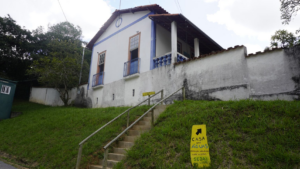
Waters House. Clarice Flores, 2024. Agência de Iniciativas Cidadãs (AIC) Collection.
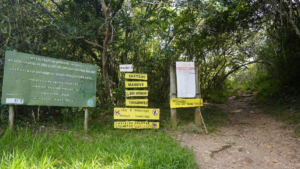
Turismo na Serra São José. Clarice Flores, 2024. Acervo Agência de Iniciativas Cidadãs – AIC.
Rio das Mortes, storyteller
Rio das Mortes follows the railway and runs at 100 meters from Tiradentes Station. These waters have been the backdrop to remarkable historical events and have witnessed centuries of daily life unfolding along its banks. The gentle murmur of its current whispers tales from different moments of the past, offering us insights into the rich history of this place. Come and discover some of the stories that Rio das Mortes has to share!
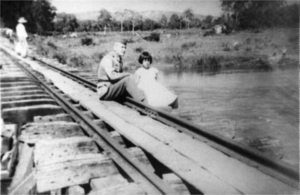
Pontilhão sobre o rio das Mortes no ramal de São João del-Rei a Águas Santas. Autoria desconhecida, década de 1940. Livro Águas Santas, memórias de uma época em nossos corações, Maria do Carmo Lopes de Oliveira Braga, 2019.
Rio das Mortes, the River of Death... the name alone sends chills down your spine! The deaths associated with it are present in a variety of stories, each with its own unique twist, yet all somehow interconnected. One might even argue they complement each other. Through these tales, we not only uncover the origins of the name Rio das Mortes but also delve into the violent backdrop of the region in the early 18th century, marked by gold exploitation, land disputes, and subjugation of indigenous peoples.
Legend has it that during the exploratory expeditions in the region, known as bandeiras, there was a port for small boats on the riverbanks, dubbed Porto Real da Passagem, between Santa Cruz de Minas and São João del-Rei. This area saw many fatal incidents, as it was surrounded by trees and became a haven for ambushes, robberies, and plundering of boat cargo, including food and gold, or the abduction of indigenous Cataguases who had been captured by other bandeirantes.
A different story recounts that Tomé Portes Del-Rei, one of the first bandeirantes from São Paulo to settle in the region, began charging tolls for crossing Rio das Mortes at Porto Real da Passagem. To avoid paying the toll, many people attempted to swim across the river, only to be swept away by the current and drown. It is also said that the river earned its name because it was the backdrop for the Emboabas War, a violent conflict where Paulistas and foreigners fiercely battled for control of the region's gold mines, resulting in numerous casualties.
Rio das Mortes can be the beginning of a boat trip to the sea! Rivers never run alone. From the lush forests of their headwaters, rivers meander, gradually collecting waters from smaller tributaries as they merge and expand into a primary river. Eventually, these waterways reach the sea, forming an interconnected network known as a hydrographic basin. Rio das Mortes serves as the main tributary of Rio Grande, which flows southward through Brazil and is part of the Rio da Prata Hydrographic Basin, emptying into the Atlantic Ocean between Argentina and Uruguay. It stands as one of the largest basins in Latin America.
Its connection to Rio Grande facilitated navigable routes from the mines to the southern continent, bestowing economic and political significance upon Rio das Mortes, especially considering the interests of the Portuguese Crown in the 18th century, as evidenced by the naming of the vast Comarca do Rio das Mortes (Rio das Mortes Judicial District). In its infancy, EFOM (Western Minas Railway) also boasted a navigational route along the river. By the late 19th century, the company inaugurated river navigation, which traversed Rio das Mortes from Antônio Carlos to its confluence with Rio Grande, reaching Porto de Ribeirão Vermelho. However, as railway lines expanded, maintaining river navigation became increasingly costly for EFOM, leading to the eventual cessation of activities on the Rio Grande and Rio das Mortes.
One of Rio das Mortes’ main tributaries, Rio Elvas originates in Serra da Mantiqueira and flows approximately 80 km until it reaches the border between Tiradentes and São João del-Rei, where it merges. Upon the arrival of EFOM, the construction of a bridge was necessary to facilitate passage across the river between the two cities. Between 1879 and 1881, the largest bridge in the vicinity was erected, featuring an iron structure, wooden sleepers, and rails imported from England. Supported by five stone pillars—three within the river and two on dry land—the bridge also included a longitudinal wooden base placed in the center of the rails for pedestrian crossing. Nowadays, the bridge over Rio Elvas stands as one of the few remaining structures of its kind, preserving its original style while remaining functional. The steam train journey between Tiradentes and São João del-Rei not only offers a view of the bridge but also allows travelers to experience this historic crossing firsthand.
As early as the 18th century, Rio Elvas served as a prominent territorial marker between the municipalities of Tiradentes and São João del-Rei. Since their inception, the Old Arraial do Rio das Mortes (Tiradentes) and the New Arraial do Rio das Mortes (São João del-Rei) had vied for control over certain lands. After decades of contention and following their elevation to the status of villages, it was decided that Vila São José del-Rei would extend “from Rio Elvas to here”. On weekends, it was common for families from Tiradentes to take walks to the bridge. However, crossing it was risky: if the train came, there was no safe place for pedestrians to wait for its passage. As part of the São João del-Rei and Tiradentes Railway Complex, the Rio Elvas Bridge was listed as a heritage site in 1989. Due to safety concerns related to structural issues caused by the river's strong current, the central pillars had to be removed and replaced with new structures replicating the originals.
The Gold Era
Exploitation of gold in Minas Gerais was one of the most significant periods of the Brazilian colonial era. In São José del-Rei, now known as Tiradentes, the gold rush occurred at the beginning of the 18th century.
“Tiradentes' main asset in the 18th century was its readily accessible surface gold. This is why there's a church here named Church of Saint Anthony of Hominy, named after the corn kernel-sized nuggets found. The wealth led to the development of the city center only, which remains preserved today. The surrounding neighborhoods were wilderness back then, dotted sporadically with houses and farms. Actual development was centralized; driven by numerous slaves extracting substantial quantities of gold. After gold resources were exhausted, the town became frozen in time.”
João Rosa da Silva Filho, resident of Tiradentes and former employee of Fábrica Cerâmica Progresso Industrial Ltda (Industrial Progress Ceramics Factory), a prominent ceramics factory in the region.
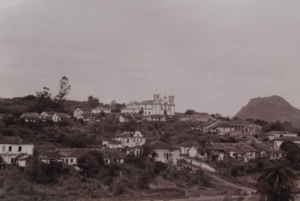
Partial view of the city, 1921. J.B. Ramalho, undated. From the book “A Matriz de Santo Antônio em Tiradentes” (The Church of Santo Antônio in Tiradentes) Brazilian National Institute of Historic and Artistic Heritage (IPHAN) Collection.
The End of the Golden Years
By the late 18th century, signs of depletion in precious stone reserves were evident. As the 19th century dawned, many who had prospered from mining moved to the Paraíba Valley in São Paulo to switch to coffee cultivation. This transition reshaped São José's economy to focus on agriculture and livestock. Efforts to revitalize the economy with textile factories and the introduction of the British-owned General Mining Association failed to yield success. Tiradentes remained stagnant for decades, with not even the arrival of the railroad in 1881 revitalizing the local economy. The economic decline of Tiradentes continued until the mid-20th century.
Ghost Town
As employment opportunities dwindled, many residents were forced to leave Tiradentes, with São João del-Rei becoming a primary destination. This period saw numerous homes and grand mansions either abandoned or left to fall into ruins. This abandonment was one of the reasons behind the designation of Tiradentes’ historical core as a protected architectural and urban heritage site in 1938 by the National Historical and Artistic Heritage Service (SPHAN), following the visit by São Paulo’s modernist artists. Unlike Tiradentes, São João del-Rei did not face economic stagnation after precious metals were depleted. It evolved into a vital hub for manufacturing and distributing goods and food, already noted for its economic dynamism by the early 18th century and serving as an important trading post between Minas Gerais and the court in Rio de Janeiro.
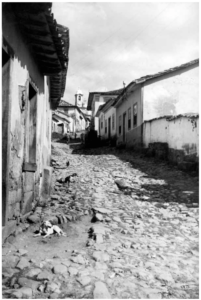
HOUSES ON RUA DA CÂMARA WITH THE TOWERS OF THE SANTO ANTÔNIO CHURCH IN THE BACKGROUND. W. J. Craig, 1948. From the book “Tiradentes Minas Gerais Imagens” (Tiradentes, Minas Gerais – Pictures), IPHAN, 2010.
“Life is slow in Tiradentes. Here, you won't find streets lit up with dazzling lights, lively parties, or the hustle and bustle of industry and commerce. It's a place where life seems scarce, where the quiet streets whisper of decay. Unless our leaders act swiftly to preserve our traditional town, all that will remain of this historic monument are ruins upon ruins. Soon, the only sounds will be the groans of collapsing walls and the lament of traditions lost.”
José Bellini dos Santos, 1941, Monograph Tiradentes: Brazilian National Census Service.
“In the 1920s, the perception of modernists about towns in Minas Gerais, including Tiradentes, sparked a movement towards preservation and official recognition. This ignited broader debates about building a national identity, leading to the protective designation of Tiradentes' Architectural and Urbanistic Ensemble in 1938. At that time, the town's buildings were deteriorating, either due to lack of maintenance capability or lack of awareness of the importance of preservation and restoration, which is recognized today. "
José Maurício dos Santos, institutional assistant at the IPHAN office in Tiradentes.
Ceramics and Silver Bring Back Hope
The expansion of Brazil's railway network and innovations in civil construction catalyzed the emergence of industrial economies in remote areas, including Tiradentes.
After the EFOM Railway reached the town, it saw the establishment of raw material extractions and factories focused on construction materials. Near the railway station, two ceramics factories and a lime factory thrived. Kaolin, used in making porcelain, paints, and cement, was mined from the nearby Serra de São José and processed close to the station.
Between the 1950s and 1960s, the city's economy received an additional boost from the production of silver jewelry, attracting numerous artisans and stimulating the local economy.
However, with the intensification of Brazilian industrialization and the emergence of larger, more efficient factories that centralized production at lower costs, these smaller local productions became unsustainable.
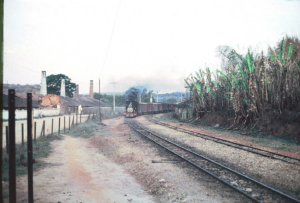
Locomotive approaches Tiradentes Station; to the left of the line, a prominent ceramics factory in the region, Fábrica Cerâmica Progresso Industrial Ltda (Industrial Progress Ceramics Factory).
Ramiro Nascimento, 1981. Personal collection.
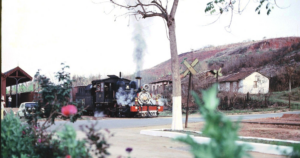
A locomotive in front of Tiradentes Station; to the right of the track, some buildings stand out, including the kaolin warehouse. Ramiro Nascimento, 1981. Personal collection.
“In my mother's house, all women and men crafted little bracelets, typically adorned with tiny silver fruits like pineapples and avocados. Everyone wanted one. They were made of nickel silver, but we told customers it was real silver. People traveled from afar to buy them, and those who made them often ended up with eyesight problems from working by lamplight to create those chains and bracelets.”
João Bosco Barbosa, retired, son of the head of São João del-Rei Station.
“The ceramic factory used to make tiles, bricks, and such. At that time, it employed around a hundred people. There was a sand quarry where they extracted sand from the mountains for making glass and ceramics. And there was kaolin too, all extracted from the mountains. Today, none of those operations are running anymore.”
João Rosa da Silva Filho, resident of Tiradentes and former employee of Fábrica Cerâmica Progresso Industrial Ltda (Industrial Progress Ceramics Factory), a prominent ceramics factory in the region.
Tourism and the Tourist Train
From the 1960s to the 1970s, Tiradentes evolved into a tourist destination celebrated for its architecture, culture, and natural settings. Initiatives to restore abandoned houses and mansions were set in motion. Organizations like Sociedade Amigos de Tiradentes (Friends of Tiradentes’ Society), and influential figures such as Yves Gomes Ferreira Alves, the regional director of TV Globo in Minas Gerais, championed the preservation of historic buildings. The Roberto Marinho Foundation played a significant role, launching numerous restoration and revitalization projects across the city. The production of soap operas, series, cultural exhibits, and festivals also played a critical role in boosting Tiradentes’ tourist appeal. Since 1985, the steam train has been a key attraction, linking São João del-Rei with Tiradentes. As of 2001, the city is part of the Estrada Real tourist route. However, gentrification remains a concern, with longtime residents being pushed from the city center to its outskirts due to rising property prices.
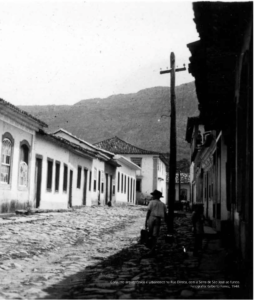
ARCHITECTURAL AND URBAN COMPLEX ON RUA DIREITA, WITH SERRA DE SÃO JOSÉ IN THE BACKGROUND. G. Ferrez, 1948. From the book “Tiradentes Minas Gerais Imagens” (Tiradentes, Minas Gerais – Pictures), IPHAN, 2010.
“Tiradentes has always been attractive for its grand mansions, churches, fountains, and museums, but what it needed was better marketing. Then Yves Alves, a director from Globo Minas, moved here. He's since passed away and is buried at the cemetery of the Santo Antônio Church. He really championed Tiradentes and effectively marketed it. There was a time when it felt like Globo's backyard here, with numerous soap operas being produced, such as 'Maria Moura,' 'Rabo de Saia,' and 'Hilda Furacão.“
João Rosa da Silva Filho, resident of Tiradentes and former employee of Fábrica Cerâmica Progresso Industrial Ltda (Industrial Progress Ceramics Factory), a prominent ceramics factory in the region.






